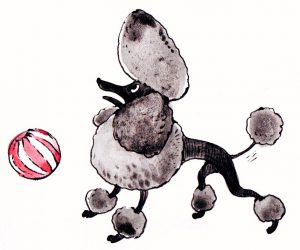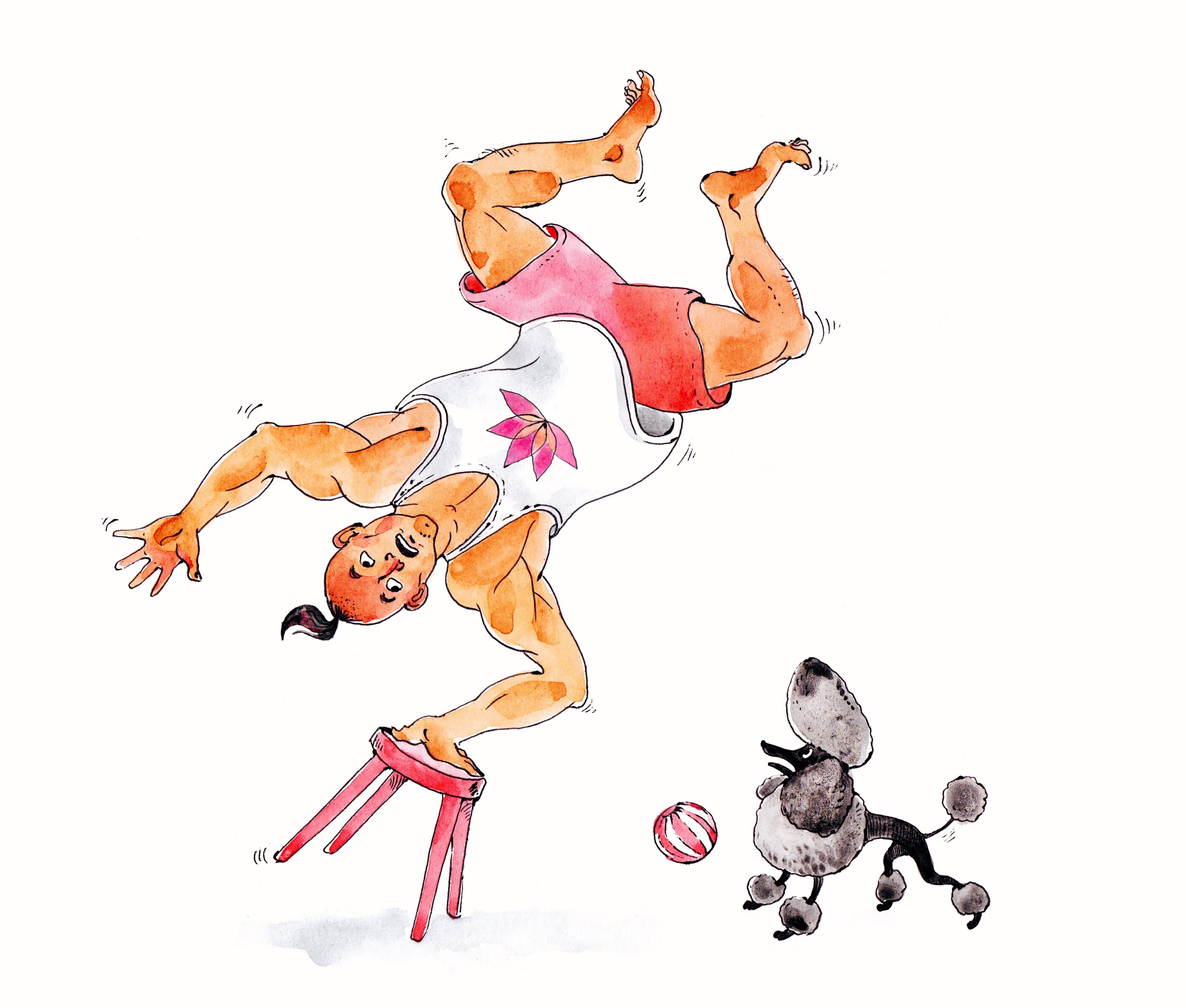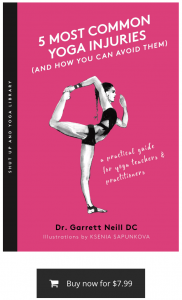A trained powerlifter walks into his first yoga class. He can bench 1.5 times his bodyweight and squat 2 times his bodyweight. The teacher cues a challenging arm balance. Will he nail the pose?
If the ability to perform a given pose was based on muscle strength alone, we might say our powerlifter friend would effortlessly float up into that handstand. Unfortunately for him, motor skills like yoga poses, require both adequate strength and motor control. Motor control is the process by which the nervous system (e.g., the brain) coordinates muscles to achieve desired movements.1 So to get into that handstand, our friend would have to train not only his muscles but also his nervous system through a process known as motor learning.2,3
Practicing a movement offers continual feedback to the brain so that motor learning can take place.4 For example, when infants are figuring out how to stand on their own, their learning brains require feedback from the wobbles, falls, and failed attempts. Similarly, when learning an arm balance (assuming muscular strength and endurance is not a limiting factor), continual practice provides the nervous system with the information it needs to both coordinate the movement and correct for perturbations. The more feedback the brain can use, the faster and more effectively it will learn. So how can we put this motor learning principle to work in our asana practice? Very simply — move your asana!
Move Your Asana
In my last article, Yoga’s Missing Nutrients, I looked at some examples of how traditional asana sequences fail to provide movement variety. One key idea I didn’t mention is that the strength-based poses we practice in asana are mostly static. That is, we get into a pose and hold it for a number of breaths. This doesn’t provide the same benefits as movement — imagine doing a bicep curl, holding the dumbbell at the top of the movement, and hoping to see the same strength and coordination gains as if you’d done reps. Of course, there is nothing wrong with holding poses statically (i.e., isometrics). Isometric contractions have benefits — they have been shown to improve strength and muscle mass gains.5,6 But, we also know that motor control and learning thrive off of continual feedback.4 In the case of poses that require more motor control than strength (think of our powerlifter friend attempting a handstand), it is paramount that we provide the nervous system with as much feedback as possible. Adding more dynamic movement to our asana practice will increase strength and neuromuscular control not only in one position but across a large range of joint positions. Our joints become happier, healthier, and better prepared for functional movement.
With a dash of creativity, it’s easy to take any asana and make it move. I’ve compiled the following six examples to get your dynamic juices flowing.

Airplane Take Offs
What I call airplane take offs are a great way to build strength and stability in the hips. Practice these, and your warrior 3 will become a piece of cake!
Begin in airplane pose. Before you move, commit to hugging your standing leg’s hip into centerline (i.e., engage your butt/outer hip). Slowly bend your standing leg as you tuck your floating leg’s knee behind your standing leg. Then reverse the movement and come back into airplane. Avoid the temptation to drop into the tucked (i.e., bottom) position — think slow and controlled.
Locust Archer-Ups
If you read my last article, you may remember that I talked about how little we tend to strengthen our posterior chain (i.e., the back body muscles). Locust archer-ups are a great way to strengthen the posterior chain and can also be easily sequenced into your vinyasa flow.
Begin lying on your stomach with your arms in a “W” shaped position — this position helps engage your lats as you pull your elbows together. Squeeze your shoulder blades together and engage your back body to lift your chest and chin. Squeeze your bum muscles as you lift your legs. Pull your heels in towards your calves to plantarflex your feet and engage your calves. Slowly lower back down and repeat.
Side plank to Wild Thing
Side plank is a challenging pose to begin with as it requires both strength and balance [think: neuromuscular control]. This typically static pose is, therefore, a great candidate for practicing with dynamic movement.
Begin in side plank and push your planted hand into the mat to lift up out of your shoulder joint. Push through your hand and the edge of your planted foot to raise your hips higher in space. Carefully lift your top leg and lower your big toe down behind you. Resist the urge to take more weight into your back toe — maybe even leave it hovering for an added challenge! Rotate your chest towards the sky as you express Wild Thing. Reverse the movement and come back into side plank.
Dolphin flows
Strengthen your chaturanga and other tricep-dominant postures with dolphin flows!
Begin in down dog and slowly lower your forearms to the mat. Press back up. If this is too challenging, you can modify by starting in down dog with planted knees (like a long table-top position).
Rhomboid Push-Ups
Rhomboid or scapular push-ups are a great way to develop a mind-muscle connection with the muscles that move the shoulder blades towards and away from the spine.
Begin in high plank. Push down through your hands and puff up your upper back to move your shoulder blades away from your spine. Lower your chest by bring your shoulder blades back towards center and squeeze them together at the bottom of the movement. Contract your abdominals throughout the movement — keep your tailbone lengthened towards your heels and don’t let your hips sag down.
High Lunge Dynamic Twists
Most twisting postures we practice in asana rely on what’s known as passive range of motion — that is, the joint’s range with the help of an external force (i.e., leverage from the arms or hands). Active range of motion describes the joint’s range using muscular contraction alone.7 To visualize this, think of how far you can bend your knee while standing using just your own leg muscles (active range) as opposed to what happens when you grab your foot and pull it towards your seat (passive range). In the case of a typical twist, we push or pull with our arms or hands to move our torso into its passive range. High lunge dynamic twists provide dynamic movement and challenge our spine’s active range.
Begin in high or low lunge. You can keep your hands at prayer or take yogi’s choice of arm expression — but don’t push or pull to deepen your twist. Inhale at center to find length in the spine and exhale to twist towards the front leg. Inhale to come back through center and exhale to twist in the opposite direction. Squeeze the muscles in your abdomen to find the furthest depth of your active range of motion for spinal rotation. Try to keep your hips square to the front of the mat, but pay attention to what feels good. For example, my SI joint feels best when I allow my hips to move a little in the direction of the twist.
Keep Moving Your Asana
Adding dynamic movement to otherwise static poses will improve our strength, balance, and stability gains from asana practice. I’m not trying to vilify static postures or isometric holds — they have benefits too. Rather, I think it’s important to understand where our movement practice excels [read: isometrics] and where it could use more attention [read: dynamic movement]. Movement variety is key to a sustainable and nutritious movement diet, and incorporating dynamic movements into your asana practice will help balance your practice. So get out there and move YOUR asana!
Have your own ideas for moving your asana? Take a video with the hashtag #moveyourasana and tag @kerrymcinnesyoga and @shutupandyoga to share!
References
- Fentress JC. Motor Control. Int Encycl Soc Behav Sci. 2001:10125-10131. doi:10.1016/B0-08-043076-7/03539-7.
- Magarey ME, Jones MA. Motor control of the shoulder region. Neck Arm Pain Syndr. 2011:279-295. doi:10.1016/B978-0-7020-3528-9.00021-2.
- Cardinale M, Newton R, Nosaka K. Strength and Conditioning : Biological Principles and Practical Applications. John Wiley & Sons, Incorporated; 2010. . Accessed March 10, 2018.
- Poole JL. Application of Motor Learning Principles in Occupational Therapy. Am J Occup Ther. 1991;45(6):531-537. doi:10.5014/ajot.45.6.531.
- Blackburn JT, F.Norcross M. The effects of isometric and isotonic training on hamstring stiffness and anterior cruciate ligament loading mechanisms. J Electromyogr Kinesiol. 2014;24(1):98-103.
- Lee SEK, Lira CAB de, Nouailhetas VLA, Vancini RL, Andrade MS. Do isometric, isotonic and/or isokinetic strength trainings produce different strength outcomes? J Bodyw Mov Ther. 2018;22(2):430-437. doi:10.1016/J.JBMT.2017.08.001.
- Roberts JM, Wilson K. Effect of stretching duration on active and passive range of motion in the lower extremity. Br J Sports Med. 1999;33(4):259-263. doi:10.1136/BJSM.33.4.259.

Illustration by Katya Uspenskaya
Edited by Jaimee Hoefert, the Scientist Yogini
Enjoyed reading this article? Consider supporting us on Patreon or making a one-time donation. As little as $2 will allow us to publish many more amazing articles about yoga and mindfulness.





